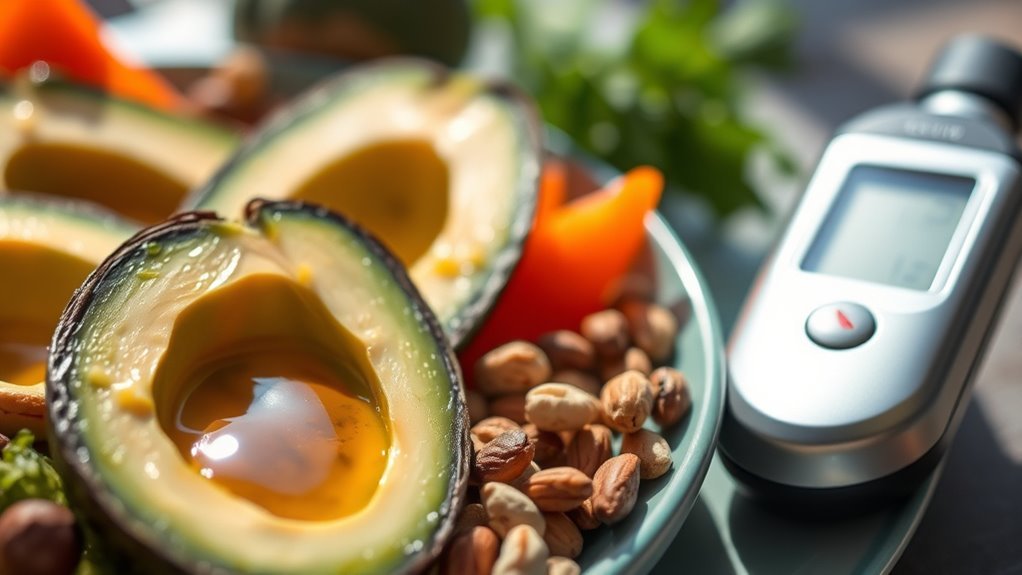The ketogenic diet doesn’t directly cause ketoacidosis, but if not managed properly, it can lead to unsafe ketone levels, especially for those with Type 1 diabetes. Ketoacidosis arises from high ketone accumulation and blood acidity, which can be exacerbated by dehydration or insulin issues. Monitoring your ketone levels, staying hydrated, and recognizing symptoms are essential for safety. Understanding these factors helps you enjoy the keto diet while minimizing risks—there’s more to explore about maintaining health on keto.
Understanding Ketoacidosis and Its Causes

While the keto diet is often praised for its potential weight loss benefits, it is crucial to understand the risks associated with ketoacidosis, a serious condition that can arise under certain circumstances. Ketoacidosis occurs when your body produces high levels of ketones, leading to an imbalance in blood acidity. The primary causes of ketoacidosis include uncontrolled diabetes, prolonged fasting, and excessive alcohol consumption. To prevent this condition, you should monitor your ketone levels regularly, stay hydrated, and avoid drastic dietary changes without medical supervision. Understanding these factors empowers you to enjoy the keto diet safely. By being aware of potential risks and implementing effective prevention strategies, you can maintain your health while pursuing your weight loss goals.
The Basics of the Ketogenic Diet

The ketogenic diet, often referred to as the keto diet, is a high-fat, low-carbohydrate eating plan designed to shift your body’s metabolism from burning glucose to burning fat for fuel. By focusing on ketogenic principles, you can achieve a state of ketosis, where your body efficiently utilizes fat. The macronutrient breakdown typically consists of about 70% fat, 25% protein, and 5% carbohydrates. Here’s a quick overview:
| Macronutrient | Percentage | Role |
|---|---|---|
| Fat | 70% | Primary energy source |
| Protein | 25% | Supports muscle maintenance |
| Carbohydrates | 5% | Minimal, for brain function |
Understanding these ratios can help you navigate your keto journey effectively, offering you the freedom to enjoy diverse foods while promoting fat loss.
How the Body Produces Ketones

When you follow a ketogenic diet, your body enters a state called ketosis, where it starts producing ketones as an alternative fuel source. This process involves breaking down fats, which is influenced by insulin levels in your body. Understanding the difference between ketosis and ketoacidosis is essential for maintaining your health while on this diet.
Ketosis Versus Ketoacidosis
Understanding the difference between ketosis and ketoacidosis is vital for anyone considering a low-carbohydrate diet. Ketosis is a natural metabolic state where your body burns fat for energy, producing beneficial ketones. You might experience ketosis benefits like increased energy and improved mental clarity. On the other hand, ketoacidosis is a dangerous condition often associated with uncontrolled diabetes, resulting in excessively high ketone levels and blood acidity. It’s important to debunk ketoacidosis myths, as they can lead to unnecessary fear about adopting a ketogenic lifestyle. Most healthy individuals can safely achieve ketosis without risking ketoacidosis. By understanding these distinctions, you can confidently explore the potential advantages of a low-carb approach while staying informed about your health.
Fat Breakdown Process
Achieving ketosis involves a fascinating metabolic process where your body shifts from using carbohydrates as its primary energy source to burning fat. This change leads to fat oxidation, where stored fats are broken down to produce ketones, which serve as an alternative fuel source. Here’s how it happens:
- Hormonal Regulation: Your body decreases insulin levels, promoting fat breakdown.
- Fat Breakdown: Triglycerides in fat cells are broken down into fatty acids and glycerol.
- Ketone Production: The liver converts fatty acids into ketones, which are utilized for energy production.
- Sustained Energy: Ketones can efficiently fuel the brain and muscles, providing an alternative to glucose.
This process allows you to experience sustained energy and mental clarity when on a ketogenic diet.
Insulin’s Role Explained
Although insulin is often associated with storing fat, it plays an essential role in the process of ketone production during a ketogenic diet. When you reduce carbohydrate intake, your body experiences lower insulin levels, which helps to alleviate insulin resistance. This reduction facilitates glucose regulation, pushing your body to utilize fat stores instead.
Here’s how insulin interacts with ketone production:
| Insulin Level | Ketone Production | Effect on Glucose Regulation |
|---|---|---|
| High | Low | Promotes glucose usage |
| Moderate | Moderate | Balances fat usage |
| Low | High | Encourages ketogenesis |
| Insulin Resistance | Impaired | Disrupts glucose regulation |
Understanding insulin’s role helps clarify how a ketogenic diet can shift your body into fat-burning mode, promoting ketone production effectively.
Differences Between Nutritional Ketosis and Ketoacidosis
While both nutritional ketosis and ketoacidosis involve elevated levels of ketones in the blood, they represent fundamentally different metabolic states. Nutritional ketosis is a safe and controlled process that occurs when you follow a low-carb, high-fat diet, leading your body to burn fat for fuel. In contrast, ketoacidosis is a dangerous condition often seen in uncontrolled diabetes, causing dangerously high ketone levels and acidity in the blood.
Here are some key differences:
- Cause: Nutritional ketosis is diet-induced; ketoacidosis often results from insulin deficiency.
- Ketone Levels: Nutritional ketosis typically results in moderate ketone levels; ketoacidosis leads to extreme levels.
- Acidity: Nutritional ketosis maintains blood pH; ketoacidosis causes acidosis.
- Health Effects: Nutritional ketosis is beneficial; ketoacidosis can be life-threatening.
Who Is at Risk for Ketoacidosis on a Keto Diet?
If you have Type 1 diabetes, you’re at a higher risk for developing ketoacidosis while on a keto diet due to your body’s inability to produce insulin. Additionally, excessive alcohol consumption can further exacerbate this risk by leading to dehydration and altered metabolism. Understanding these factors is essential for safely maneuvering a ketogenic lifestyle.
Diabetes Type 1 Risk
Understanding the risks associated with a ketogenic diet is fundamental, especially for those with Type 1 diabetes, as they are more susceptible to ketoacidosis. If you’re managing diabetes with insulin therapy, it’s imperative to stay informed about how your diet may affect your health. Here are some key points to reflect on:
- Insulin Needs: A ketogenic diet can alter your insulin requirements.
- Blood Sugar Levels: Monitoring your blood glucose is essential to prevent drastic changes.
- Symptoms of Ketoacidosis: Recognizing early signs like nausea or confusion can be life-saving.
- Consult Healthcare Providers: Always discuss dietary changes with your doctor to guarantee effective diabetes management.
Being proactive in your health choices can help you enjoy the freedom a ketogenic lifestyle offers while minimizing risks.
Alcohol Consumption Impact
Alcohol consumption can greatly influence the risk of ketoacidosis for individuals on a ketogenic diet, particularly for those with diabetes. When you drink alcohol, your body prioritizes alcohol metabolism over fat oxidation, potentially disrupting the keto effects you’re aiming for. This can lead to fluctuations in your blood sugar and ketone levels, increasing your risk of ketoacidosis, especially if you’re not monitoring your intake closely.
If you have diabetes, the combination of alcohol and a ketogenic diet can complicate your metabolic balance. It’s essential to be aware of how alcohol affects your body’s ability to maintain ketosis. Moderation and awareness of your personal limits can help you enjoy freedom while minimizing risks associated with ketoacidosis. Stay informed and prioritize your health!
Signs and Symptoms of Ketoacidosis
Ketoacidosis is a serious condition that can arise when the body produces high levels of ketones, leading to a dangerously acidic environment in the bloodstream. Recognizing the warning signs early can be vital for your health. Here are some keto symptoms to watch out for:
Ketoacidosis can lead to serious health risks; recognize the warning signs to protect yourself.
- Excessive thirst or dry mouth
- Frequent urination
- Nausea or vomiting
- Fruity-smelling breath
If you experience these symptoms, it’s important to seek medical attention immediately. Ignoring them can lead to severe complications. While the ketogenic diet can offer many benefits, being aware of these signs guarantees you can enjoy the freedom of this lifestyle without jeopardizing your health. Stay informed and always listen to your body!
Tips for Safely Following a Ketogenic Diet
While starting a ketogenic diet can be rewarding, it’s essential to approach it with care to avoid potential pitfalls. Begin with thorough meal planning; this helps guarantee you’re getting the right balance of fats, proteins, and low-carb vegetables. Consider prepping meals in advance to stick to your goals and resist temptations. Don’t forget about hydration strategies, as a keto diet can lead to increased water loss. Aim to drink plenty of water and consider adding electrolytes to your routine to maintain balance. Monitor how you feel, and adjust your food choices if you experience fatigue or dizziness. Finally, consult a healthcare professional before making significant dietary changes to confirm the diet suits your individual health needs.


